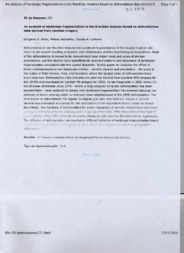An analysis of landscape fragmentation in the Brazilian Amazon based on deforestation data derived from Landsat imagery.
An analysis of landscape fragmentation in the Brazilian Amazon based on deforestation data derived from Landsat imagery.
Author(s): ALVES, D. S.; BATISTELLA, M.; LINHARES, C. A.
Summary: Deforestation in the Brazilian Amazon has produced fragmentation of the largest tropical rain forest in the planet resulting in impacts over biodiversity and the functioning of ecosystems. Most of the deforestation is known to be concentrated near major roads and areas of pioneer colonization, but few studies have quantitatively analyzed patterns and processes of landscape fragmentation associated with this spatial dynamics. In this paper we evaluate the effect of forest clearing based on two landscape metrics - percent cleared and percolation - for areas in the states of Mato Grosso, Pará, and Rondônia where the largest rates of deforestation have been observed. Deforestation data included one data set derived from Landsat MSS imagery for the 1970?s and one based on Landsat TM imagery for 2006. Forest fragments in 2006 within 25-km of areas deforested since 1978 - where a large majority of recent deforestation has been concentrated - were analyzed to assess how landscape fragmentation has evolved following the diffusion of forest clearing within a relatively close neighborhood of the 1978 deforestation. The distribution of deforestation for regular ¼-degree grid cells with different values of percent cleared was estimated as a proxy for the distribution of the equivalent metric based on actual farm limits. The fractions of deforestation for larger categories of percent cleared have increased during the diffusion of forest clearing and a majority of the total 2006 deforestation belonged to areas with less than 50% of forest remnants, taking as reference the Brazilian forest regulations. The diffusion of deforestation has resulted in different patterns of landscape fragmentation based on estimated percolation and we propose an analysis of such patterns based on geographic differences.
Publication year: 2008
Types of publication: Abstract in annals or event proceedings
Unit: Embrapa Territorial
Keywords: Amazonia, Florestas Amazonica, Fragmentação da Floresta
Observation
Some of Embrapa's publications are published as ePub files. To read them, use or download one of the following free software options to your computer or mobile device. Android: Google Play Books; IOS: iBooks; Windows and Linux: Calibre.
Access other publications
Access the Agricultural Research Database (BDPA) to consult Embrapa's full library collection and records.
Visit Embrapa Bookstore to purchase books and other publications sold by Embrapa.

